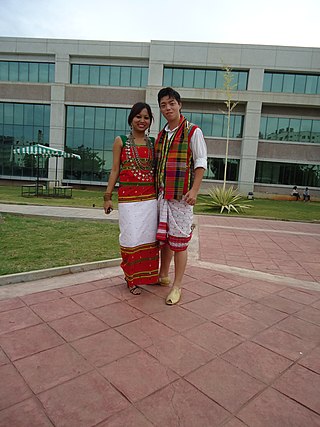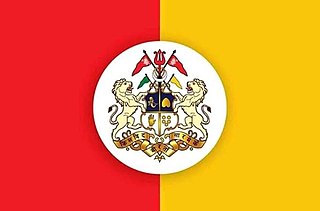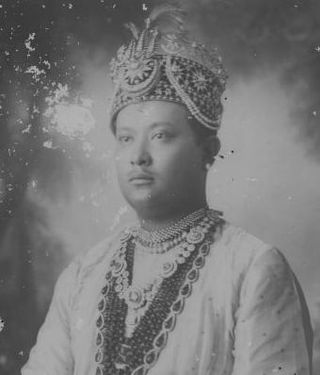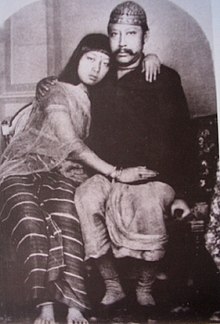
Agartala is the capital and the largest city of the Indian state of Tripura, situated on the banks of Haora River, about 2 kilometres (1.2 mi) east of the border with Bangladesh and about 2,499 km (1,552 mi) from the national capital, New Delhi. According to 2022 census, Agartala is the third largest city after Guwahati and Imphal in Northeast India. It is India's third international internet gateway and being developed under the Smart Cities Mission.

The State of Tripura, in northeastern India, has a long history. The Twipra Kingdom at its peak included the whole eastern region of Bengal from the Brahmaputra River in the north and west, the Bay of Bengal in the south and Burma to the east during the 14th and 15th centuries AD.

The Tripuri are a Tibeto-Burman-speaking ethnic group of Northeast Indian state of Tripura. They are the descendants of the inhabitants of the Twipra/Tripura Kingdom in North-East India and Bangladesh. The Tripuri people through the Manikya dynasty ruled the Kingdom of Tripura for ~450 years until the kingdom joined the Indian Union on 15 October 1949.

Kokborok (Tiprakok/Tripuri) is the native language of Tripuri people in present Tripura state in North East of India. During the 20th century many of Royal family and its officials contributes to develop the Kokborok language in many ways.
Rajmala is a chronicle of the Kings of Tripura, written in Bengali verse in the 15th century under Dharma Manikya I.

Debbarma is the main clan of Tripuri community, predominantly in state of Tripura, India and Bangladesh who speak Kokborok, a Tibeto-Burman language.
The Tripura Merger Agreement was the official agreement under which the erstwhile Kingdom of Tripuri joined the state of India.

The Twipra Kingdom was a Hindu kingdom of Tibeto-Burman ethnic dynasty of the Tripuri people in Northeast India.

The Manikya dynasty was the ruling house of the Twipra Kingdom and later the princely Tripura State, what is now the Indian state of Tripura. Ruling since the early 15th century, the dynasty at its height controlled a large swathe of the north-east of the Indian subcontinent. After coming under British influence, in 1761 they transitioned from feudal monarchs into rulers of a princely state, though the Manikyas maintain control of the region until 1949, when it ascended in union with India.

Maharaja Bir Bikram Kishore Manikya Debbarma Bahadur was a king of Tripura State.

Pradyot Manikya Deb Barma is the current titular King and statesman from Tripura. He was born in New Delhi, and now resides in Agartala, Tripura. He also served as the editor of TNT-The Northeast Today. He is the current chairman of The Indigenous Progressive Regional Alliance also known as TIPRA Motha. He is known as 'Bubagra' among his people and is one of the active voices for the rights of Indigenous Tripuri people of Tripura.
Mahamanyabar Rajkumar Srila-Srijukta Nabadwipchandra Dev Burman, also transliterated as Nabadwip Chandra Deb Barman, was a noted Indian sitarist and Dhrupad singer. He was the father of composer S. D. Burman and grandfather of another composer R. D. Burman.
Tripuri Kshatriya is a Vaishnav caste group which encompasses almost all the members of the Tripuri, Reang, Jamatia and Noatia ethnic groups, most of whom live in the Indian state of Tripura. The Tripuri Royal Family belonged to the Tripuri ethnic group, from the Debbarma clan. Originally the term "Tripur Kshatriya" was used to denote the Tripuri ethnic group only, but in due time, the Maharajah included the remaining three ethnic groups as well, in an attempt to foster a sense of kinship among his people. With the influx of the Bengali immigrants from neighboring places, the Tripuris lost their majority in their own kingdom and the Maharajah's power was taken away by the Indian government. Formerly, the community was organized under the Tripura Kshatriya Samaj, which was headed by the Maharajah of Tripura himself.

Maharaja Bir Chandra Manikya Bahadur of the Manikya Dynasty was the king of Tripura from 1862 to 1896.

Maharani Kanchan Prava Devi was a Queen of Tripura as the wife of Bir Bikram Kishore Debbarma, King of Tripura State. After her husband's death in 1947, she was regent of Tripura until it was merged with India in 1949.
Maharaja Kirit Bikram Kishore Manikya DebBarma Bahadur was the 185th and last King of Tripura, a princely state in northeastern India. His formal coronation was held in 1941, but he never gained the powers of a king.

The Tipra Motha Party (TMP), also known as the Tipraha Indigenous Progressive Regional Alliance, is a regional political party and previously a social organisation in Tripura, India. The TIPRA is led by Pradyot Bikram Manikya Deb Barma. It is currently the second largest party in Tripura Legislative Assembly

Kokborok Cinema refers to the Kokborok language film industry in Tripura, India and among the Tripuri people. Tripura's Kokborok film industry began in 1986 with Longtharai (1986) directed by Dipak Bhattacharya adapted from Bimal Sinha's novel Karachi theke Longtharai depicting the struggle-ridden life of jhum cultivators in the rural hills of Longtharai followed by the Kokborok film Langmani Haduk (1993) directed by Ruhi Debbarma can be read as a critique of the modern regime. The Kokborok film Mathia (2004) directed by Joseph Pulinthanath, is the first International Award-winning Kokborok film.

Kriti Singh Debbarma is a Tripuri princess from the Manikya Royal Family of Tripura. She is the joint candidate of Tipra Motha Party and BJP from Tripura East Lok Sabha constituency for the 2024 Indian general election.





















